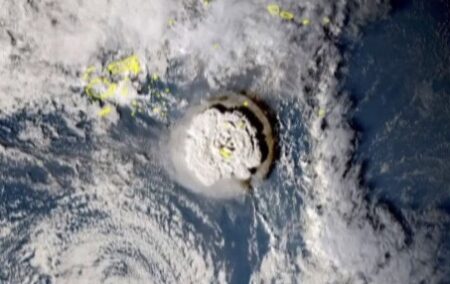The massive underwater eruption of the Hunga Tonga-Hunga Ha’apai volcano off Tonga was so powerful it was recorded around the world, and triggered a tsunami that flooded Pacific coastlines from Japan to the United States.
Satellite images showed the long, rumbling eruption of the volcano which spewed smoke and ash into the air, with a thunderous roar heard 10,000 kilometres away in Alaska.
The US Geological Survey recorded Saturday’s eruption as equivalent to a 5.8 magnitude earthquake at zero depth.
However the full extent of the damage in Tonga is unclear because communication lines were down.
A 1.2-metre wave hit the Tongan capital Nuku’alofa. Locals fled to higher ground, leaving behind flooded houses, some with structural damage. Small stones and ash were falling from the sky. The volcano lies about 65 kilometres north of Nuku’alofa.
A New Zealand scientist at Otago University’s School of Geology described the impact of the eruption as “relatively mild”, but said another eruption with a much bigger impact could not be ruled out.
Waves of around 1.2 metres hit Japan’s Pacific coast with the Japan Meteorological Agency warning that waves as high as three metres were possible.
In New Zealand, more than 2,300 kilometres from Tonga, 120 people were evacuated from northern coastal areas and several boats destroyed when a huge wave crashed into a marina.
Australia’s Bondi Beach in Sydney was briefly evacuated as a precaution while in California, coastal streets in Santa Cruz were awash and closed to traffic.
The Alaska Volcano Observatory recorded the eruption in Anchorage and Fairbanks, ‘6,000 miles from the volcano’.
The Fife weather station in Scotland tweeted it was “just incredible to think of the power that can send a shockwave around the world” after the eruptions produced a jump in its air pressure graph.

